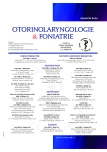The Physiology and Pathophysiology of the Nasal Airflow
Authors:
M. Plášek 1,2; M. Bojko 3; M. Masárová 1,2; Petr Matoušek 1,2; Pavel Komínek 1,2
Authors‘ workplace:
Klinika otorinolaryngologie a chirurgie hlavy a krku, Fakultní nemocnice Ostrava
1; Katedra kraniofaciálních oborů, Lékařská fakulta, Ostravská univerzita v Ostravě
2; Katedra hydromechaniky a hydraulických zařízení, Fakulta strojní, Vysoká škola báňská, Technická univerzita Ostrava
3
Published in:
Otorinolaryngol Foniatr, 67, 2018, No. 4, pp. 113-118.
Category:
Review Article
Overview
The physiological nasal airflow with low resistance and low level of turbulences is necessary for normal nasal breathing. Pathological conditions (e.g. septal deviation/perforation) cause elevation of nasal resistance that patients feel like nasal obstruction. The nasal obstruction worsens quality of life. There are some possibilities how to simulate and study nasal airflow - mechanic models or computational fluid dynamics (CFD). Nowadays, CFD is dominant method for simulating nasal airflow. There is a potential to apply aerodynamic information to clinical rhinology and rhinosurgery.
Keywords
nasal airflow, computational fluid dynamics, laminar/turbulent airflow
Sources
1. Cannon, D. E., Frank, D. O. et al.: Modeling nasal physiology changes due to septal perforations. Otolaryngol. Head Neck Surg., 148, 2013, 3, s. 513-518.
2. Cole, P., Chaban, K. et al: The obstructive nasal septum. Eur. Arch. Otolaryngol., 114, 1988, s. 410-412.
3. Fairbanks, D. N.: Closure of nasal septal perforations. Eur. Arch. Otolaryngol., 106, 1980, s. 509-513.
4. Grützenmacher, S., Mlynski, R. et al.: The nasal airflow in noses with septal perforation: A model study. ORL, 67, 2005, s. 142-147.
5. Grützenmacher, S., Robinson, K. et al.: First findings concerning airflow in noses with septal deviation and compensatory turbinate hypertrophy - a model study. ORL, 68, 2006, s. 199-205.
6. Grützenmacher, S., Lang, G. et al.: The combination of acoustic rhinometry, rhinoresistometry and flow simulation in noses before and after turbinate surgery: a model stud. ORL J. Otorhinolaryngol., 65, 2003, s. 341-347.
7. Harriri, B. M., Rhee, J. S. et al.: Identifying patients who may benefit from inferior turbinate reduction using computer simulations. Laryngoscope, 125, 2015, s. 2635-2645.
8. Illum, P.: Septoplasty and compensatory inferior turbinate hypertrophy: long-term results after randomized turbinoplasty. Eur. Arch. Otorhinolaryngol., 254, 1997, s. 89-92.
9. Mlynski, G., Grützenmacher, S. et al.: A method for studying nasal airflow by means of fluid dynamics experiments. Z. Med. Phys., 10, 2000, s. 207-214.
10. Önerci, T., Shimzu, T., Mlynski, R. et al.: Nasal physiology and pathophysiology of nasal disorders. Springer-Verlag Berlin Heidelberg, 2013, s. 280-300, 323-356.
11. Passali, D., Spinosi, M. C. et al.: Surgical treatment of nasal septal perforation - expert opinion. Acta Otorhinolaryngol. Esp., 68, 2017, s. 191-196.
12. Sičák, M., Vokurka, J., Barta, T. et al.: Rinológia - choroby nosa a prinosových dutín, prvé vydanie. Kozák-press, 2006, s. 13-30, 33-41.
13. Simmen, D., Heinz, B. et al.: A dynamic and direct visualization model for the study of nasal airflow. Arch. Otolaryngol. Head Neck Surg., 125, 1999, s. 1015-1021.
14. Weinhold, I., Mlynski, G. et al.: Numerical simulation of airflow in the human nose. Eur. Arch. Otolaryngol., 261, 2004, s. 452-455.
15. Zhao, K., Jiang, J. et al.: What is normal nasal airflow. A computational study of 22 healthy adults. Int. Forum Allergy Rhinol., 4, 2014, 6, s. 435-446.
Labels
Audiology Paediatric ENT ENT (Otorhinolaryngology)Article was published in
Otorhinolaryngology and Phoniatrics

2018 Issue 4
Most read in this issue
- The Etiology, Diagnostics, Nasal Defects Classification and History of Nasal Reconstruction
- The Physiology and Pathophysiology of the Nasal Airflow
- Manifestations of the Chronic Granulomatous Disease in ENT Locality
- Adenoid Cystic Carcinoma of the Trachea
